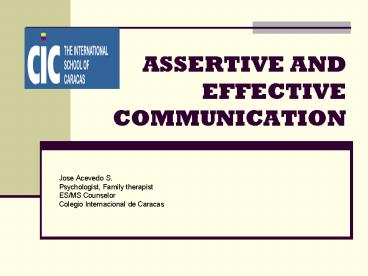ASSERTIVE AND EFFECTIVE COMMUNICATION PowerPoint PPT Presentation
1 / 12
Title: ASSERTIVE AND EFFECTIVE COMMUNICATION
1
ASSERTIVE AND EFFECTIVE COMMUNICATION
- Jose Acevedo S.
- Psychologist, Family therapist
- ES/MS Counselor
- Colegio Internacional de Caracas
2
What is Communication?
- Concept
- a process in which something is a sign to some
organism (Morris 1946) - Shannon Weaver define communication as
- all the procedures by which one mind may affect
- another. This involves not only written and oral
- speech, but also music, the pictorial arts, the
- theatre, the ballet, and in fact all human
behaviour - (1949)
- IB Learner Profile
3
Roles and Models
- Roles
- transmitter (Sender)
- Receiver
- Linear model Shannon Weaver (1949)
- Information Source Transmitter
Channel Receiver Destination - Message Signal
Received signal Message - Circular Model
- Transmitter
Environment Receiver
4
- It is not possible to NOT communicate!
- What do you think?
5
How are you feeling?
I am glad!
I am so happy!
I am so sad!
6
Types and levels of communication
- Types
- Verbal
- Non Verbal Hand out No.
- Levels
- Frontal (Straight)
- Confusing
- Ulterior
- Report and Command being aware of hierarchies
- Different logical levels
7
Logical Levels
- Example A
- It is not possible to NOT communicate!
- analyze whether the statement is true or false
- debate on what the statements mean
- Example B
- Dinner is ready!
- Come and eat now
- Come and eat when you want to
8
The best friends of communication
- Assertiveness
- Being attentive
- Circularity
- Empathy imaging or using intuition to understand
how someone else might be feeling - No assumptions, create questions
- Perception
- Feeling Vs. Thinking
9
Roles Responsibilities
- Sender
- Assertiveness, frontal, coherence between verbal
and non-verbal messages, aware of hierarchies,
aware of verbal abilities, respects timing
between sender and receiver, is clear about the
logic of the message, checks if it was well
understood - Receiver
- Empathy, responds accordingly to needs and
situation, avoids assumptions and checks
10
Communication and chronological age
- 8 years old Listens, but so full of ideas cannot
always recall what has been said - 9 years old Age of negatives
- 10 years old Good listeners, actively receptive
- 11 years old Impulsive talks before thinking
- 12 years old Double meanings, jokes of
intellectual interest - 13 years old One word answers to adult questions
- 14 years old Peer language of most importance,
but also ready to negotiate adult world
11
RESOURCES
- BOOKS
- Rosemarie Smead Morganett. Skills for Living.
1990 - Gwendolyn Cartledge and Joanne Fellows Milburn.
Teaching Socila Skills to Children and Youth,
third edition. 1995 - Peter Jaksa. 25 Errores que Cometen los Padres y
que podrian evitarse facilmente. 1998 - Chip Wood. Yardsticks, Children in the Clasroom
4-14. A resource for parents and teachers. 1997 - Alan Carr, Family Therapy. Concepts, process and
Practice. 2000 - Daniel Benveniste. Psychlogical Perspectives on
Every day Life. 2005 - IN TERNET
- http//www.f03.fh-koeln.de/imperia/md/content/pers
onen/cerny_lothar/the_concept_of_communication.pdf
12
THANKS FOR COMMUNICATING

